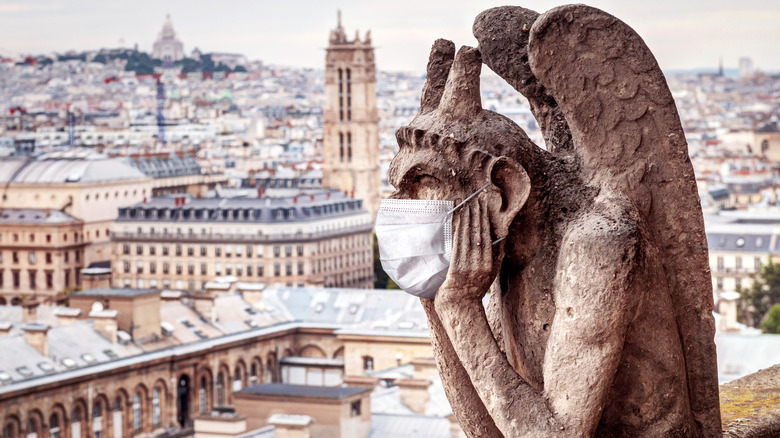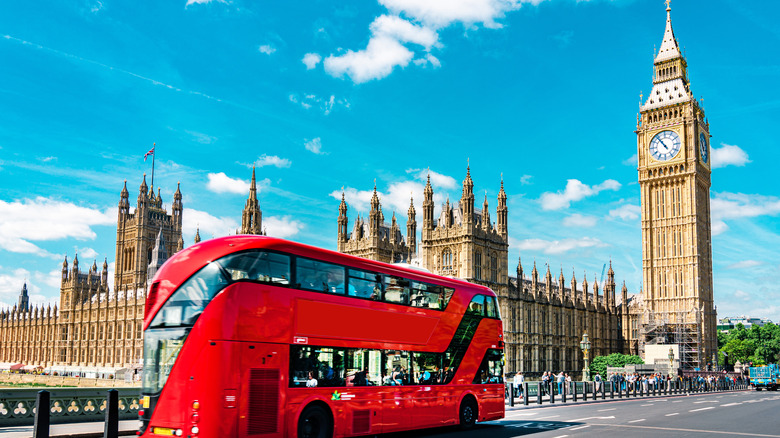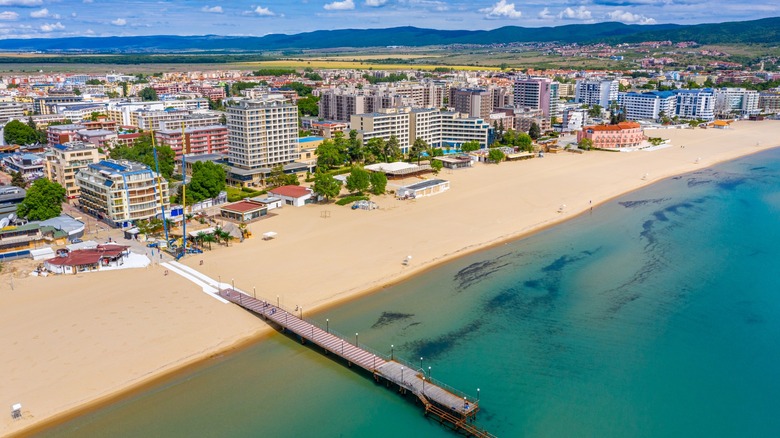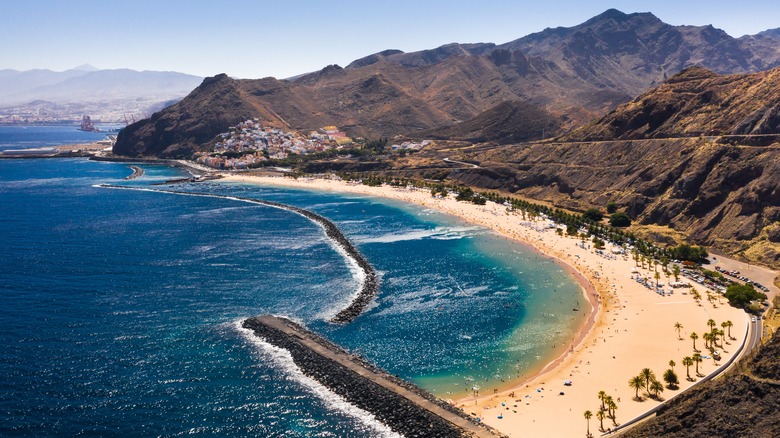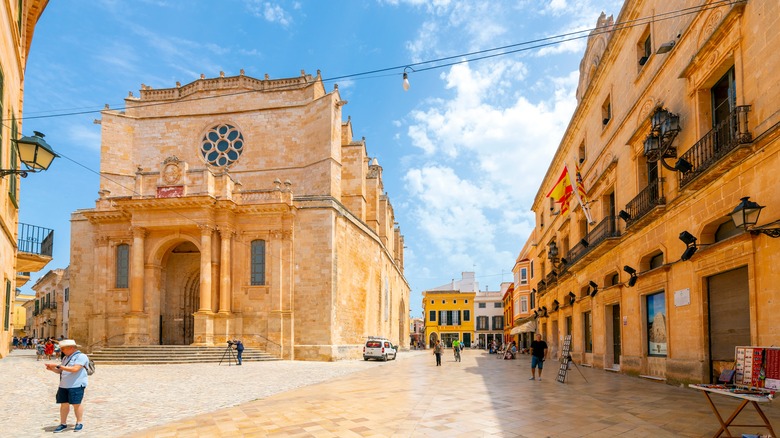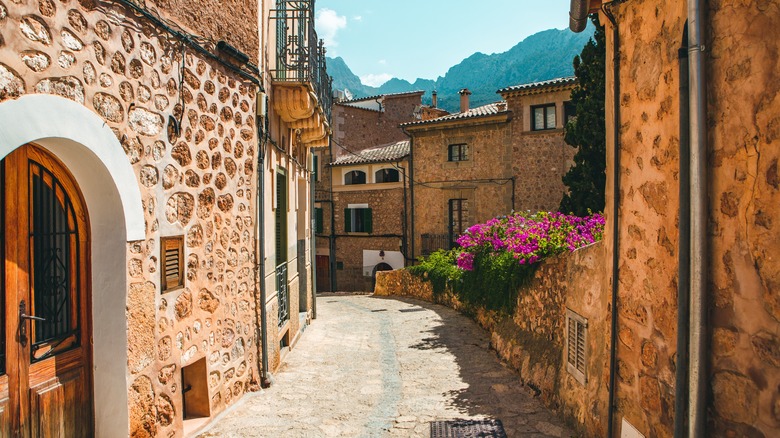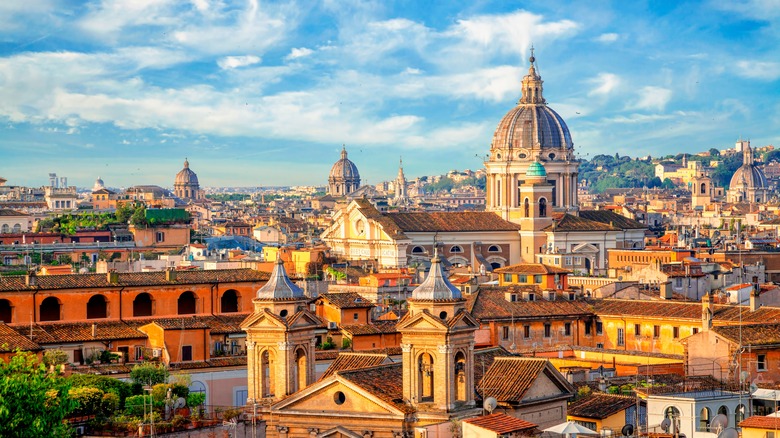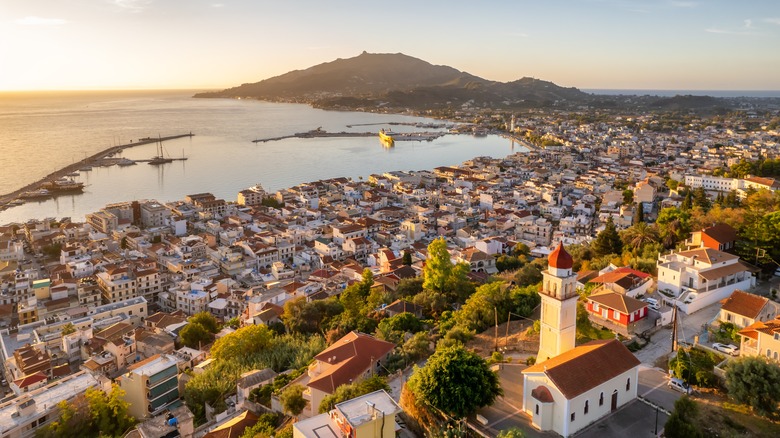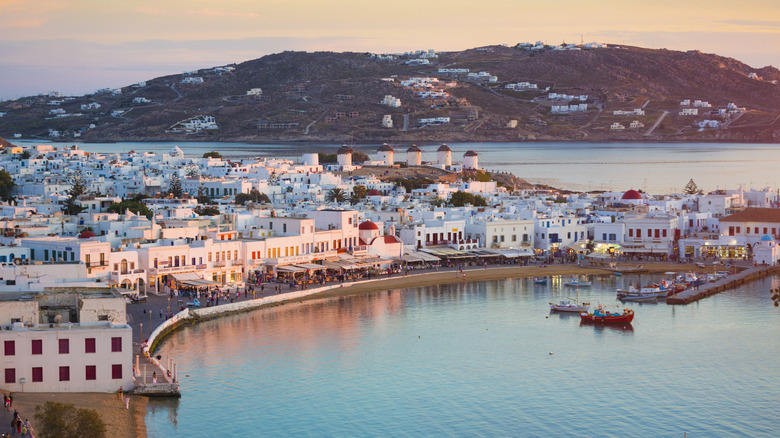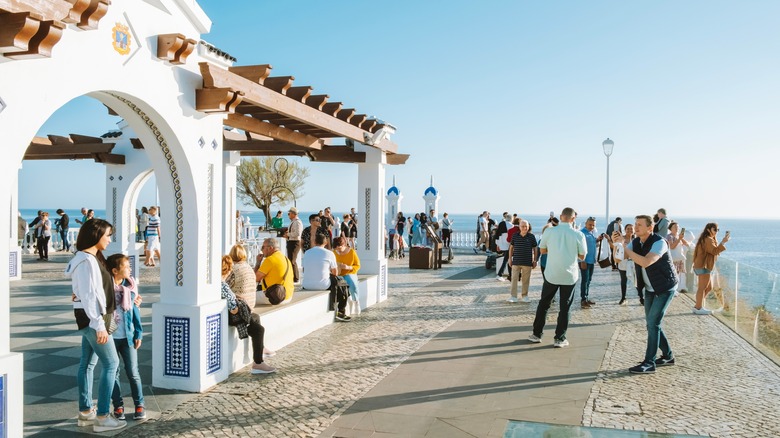Destinations In Europe Where Tourists Get Sick Most Often
Traveling in Europe offers a culturally vibrant awakening. Experienced explorers can find all kinds of iconic destinations across the continent, from the never-ending range of cafes in Paris to Tallinn's immaculately preserved Old Town walls, while the beaches are brilliant and the hiking comes Rick Steves-approved. The continent is brimming with opportunity, history, and a diverse range of cultural spheres that intermingle and imprint upon one another in a beautiful tapestry of individualism and community at the same time.
Even with such wonderful experiences waiting for travelers to embrace while away on vacation, some precautions must be taken. For one thing, foreign countries serve food prepared in ways that differ from the typical meal you may be accustomed to. Traveler's diarrhea is a term specifically dealing with sickness while abroad and is thought to stem partially from the stress of a new climate and the travel demands themselves. The food in new locales may contain different bacteria than you are used to, leading to frequent stomach issues. It's also possible to encounter a restaurant that deploys lax health standards. This can occur anywhere, but is more damaging to you when you find yourself in a new place. When traveling, it's always a good idea to think about ways your health may be negatively impacted. Fortunately, Forbes has put together a sickness index that assists travelers with their wellness planning. These are the destinations in Europe where visitors get sick the most often, so take extra precautions if you can.
London, United Kingdom
For some, London might be an unexpected inclusion on this list. It's a modern city with solid health standards and plenty of options to fit any budget, travel priorities, and entertainment interests. However, London topped Forbes Advisor U.K.'s list of unique sickness reports and came second in incidence rate among all European travel destinations. This is perhaps due to the diverse range of experiences you might find visiting the English capital. All manner of international flavors come together in London's street markets and restaurant scene, and both expensive luxury and cheap eats are peppered throughout the city. Plenty of great drinking spots litter the town, making for a glutton's paradise while away on vacation. London isn't just the political capital of the U.K., though; it's also a great place to go celebrity spotting! England and the wider U.K.'s cultural heavyweights call London home in droves, and foreign visitors are constantly seen pounding the pavement or nipping into a local haunt for dinner or drinks.
London has a score of 21.7 in the Forbes index, the result of a massive volume of reported sicknesses when visiting. It's likely that the large number of reports — over 4,200 of them — comes as a result of the city's truly gigantic influx of tourists. Around 30 million people visit London on a yearly basis, offering ample opportunity for reports of illness to stack up in droves.
Sunny Beach, Bulgaria
Sunny Beach is another destination many people might be surprised to hear in this conversation. This one's not a major head-scratcher for the same reason as London, though. Frankly, many might not be familiar with Eastern Europe's sunny holiday towns, and Bulgaria's Black Sea haven is among those underappreciated by American travelers. Sunny Beach is, however, the only city on this list that runs questionable water through its piping, and multiple sources recommend avoiding drinking the water here. Local resources suggest that tap water is fine to drink, but a different standard of iron and minerality leads many to suggest that the water doesn't taste very good. If you aren't used to the water — which most first-time travelers to the region or city will not be — then sticking to bottled water is always advisable.
Sunny Beach received a 21.5 rating on Forbes Advisor U.K.'s travel bug index. This appears to be primarily driven by a high percentage of posts regarding illnesses. While there were only 470 reports of travelers visiting Sunny Beach falling ill, they make up a large volume of the total reports on holiday experiences at the seaside destination (2.77% of all posts). This makes Sunny Beach a bit of a horrid health hotspot within Europe, with the relative percentage of visitors rising past all but a select few other European destinations.
Paris, France
Paris is another titan of culture in Western Europe, and it may yet again come as a shock that visitors report sickness at a somewhat elevated rate in the French monolith. It's a place packed to the brim with riverside cafes and restaurants offering an experience to die for, but the Seine has long been considered toxic, and visitors are somewhat susceptible to food poisoning and other sickness issues while traveling to the City of Light.
However, things are potentially looking up. With the Paris Olympics coming around in the summer of 2024, organizers have maintained a positive outlook on the potential for using the Seine as a racecourse for several long-distance swimming events. The river runs directly through the city, and its use in the athletic extravaganza would be a point of great pride to Parisians, who have essentially been banned from swimming in its unsafe waters over the last hundred years (since 1923).
Much like London, the sheer volume of travelers making the journey to Paris likely contributes to its heightened score on the Forbes Index. A 19.4 score is gifted to the City of Light, with an aggregate number of reports rising to just under 4,200 and a sickness-mention percentage hovering slightly below Sunny Beach's rating, at 2.75% among Parisian travelers' posts. All in all, visitors aren't likely to experience much in the way of gastrointestinal sickness, but the potential is certainly there, and intelligent decision-making should remain a priority.
Tenerife, Spain
Tenerife is another place where tourists frequently complain of stomach bugs and other illnesses. Unlike many of Spain's other tourist magnets, Tenerife is flung out into the Atlantic Ocean and is so far from the European mainland that the island is closer to Morocco than its governing nation's primary coastline. The remote nature of Tenerife makes it a place where viruses are able to spread rapidly, compounded by the island's reputation as a party spot where drinks flow freely and crowds can congregate in large masses. Forbes assigns the Spanish island a 19.4 on its travel bug index. Tenerife is similar to Benidorm in the fact that it experiences both a decently high volume of reports (1,700), while its percentage is also raised above the typical figures seen among relatively similar destinations on the index's highest travel bug spots. Tenerife visitors report coming down with something in 3.17% of all posts.
Tenerife's geography makes it a wonderful destination for travelers looking for breathtaking beaches and an enriching cultural experience. It's known as the Island of Eternal Spring and offers year-round temperatures between 65 and 75 degrees Fahrenheit. The island is often busy, but it's well worth a visit for anyone seeking a fun and relaxing sunny holiday. It's worth noting, however, that locals are currently in the midst of protests over practices within the tourism industry. If you are going to visit, remaining respectful and being mindful of these concerns is a good idea.
Menorca, Spain
Spain perhaps gets a bad rap when thinking about sickness among tourists. Menorca also makes the list chronicling frequent sickness reports among visitors, but it's important to keep the setting in mind. All of Spain's hot spots for tourist illness can be found in the sunnier coastline and island locations, and each one of them represents a prime drinking vacation area that attracts those looking for cheap eats and great drink deals. Even though Menorca is a little more laid back than Ibiza or Benidorm, many tourists visiting the Mediterranean island spend the day at the pool, beach, or bars, and gorge on street food throughout their time on Spain's sun-washed eastern shores before hitting the town to take in the holiday destination's raucous nightlife. These coalesce to create ample opportunity for sickness to manifest.
Menorca was levied with a score of 13 on the Forbes travel bug index. Tap water is safe to drink, and no vaccinations are required or advised for travel (although jabs for Hepatitis A and B are recommended for high-risk travelers, and a tetanus shot is floated as something to consider by the U.K's NHS) to the tiny Mediterranean island off the Spanish coastline. However, a decent percentage of visitors still complain of illness-related issues. Only 404 posts regarding sickness were uncovered during the survey, but they accounted for 3.18% of all visitor reports on Menorca, marking the second-highest rate in Spain behind just Benidorm.
Mallorca, Spain
The final Spanish tourist destination to feature on this list, Mallorca (also known as Majorca) is another Mediterranean island off the Spanish mainland's southeast coast. Unsurprisingly, it is yet another sun-drenched beach paradise that offers great drink specials and a plethora of nightlife options that draw in crowds of young tourists on holiday every year. The island fits the same mold as nearly every other destination featured here: a hot climate, cheap drinks, and hefty crowds seeking a cost-effective weekend away, complete with nightlife and pool or beachside relaxation. Palma is a particularly enticing draw for travelers hoping to explore the Balearic Islands culture while getting their fill of fantastic nightlife events. Not far from Santa Ponsa and Magaluf — two thumping destinations for a great drinking holiday, Palma's old town streets deliver the perfect blend of charming history and modern bar scenery.
This island is larger and just south of Menorca. Santa Ponsa and Palma also double as the primary holiday destinations for partiers and vacationers looking for all-inclusive offers, adding to the island's boozy reputation. Mallorca received a score of 12.1 on the travel bug index released by Forbes Advisor U.K., with 1,550 total posts relating to illnesses on vacation and a hit rate of 2.52%.
Rome, Italy
Rome isn't a destination that sees a high percentage of illnesses among tourists, but it showcases a large number of reports in the Forbes Index. This is likely due to the massive volume of people who travel to Rome on a yearly basis. Almost 27 million visitors stomped through Rome's montage of modern and ancient streets in 2021, growing to roughly 35 million who saw the Eternal City in 2023. These numbers lead to a melting pot of cultural diffusion, as well as a breeding ground of potential illness that could easily spread through a congested population of individuals craning for views of the Trevi Fountain, Colosseum, and Roman Forum (among a laundry list of other brilliant things to do in Rome).
Combined with a culture that prizes cured meat and fish products, these features can lead those with less adventurous guts into unwitting distress. While Americans might consider themselves well-versed in Italian food culture, there's a wide variety of rich, locally curated dishes and delicacies you'll find in Italy that can easily challenge the palate and digestive system if you aren't prepared. A travel bug index rating of 12.1 is given to Rome based on a low percentage (2.19%) and a relatively high total number of reports compared to some other destinations. Rome received 2,210 mentions, a high number in a vacuum but nowhere near as large as Paris or London.
Zakynthos, Greece
Also known as Zante, Zakynthos is one of the largest islands in the Ionian Sea, located to the west of the Grecian mainland and south of Kefalonia. The so-called Flower of the East is a hopping holiday destination that brings Europeans and others to its beaches throughout the year. However, free-flowing drinks and island food quickly intermingle with the hefty influx of travelers, creating a hospitable environment for foodborne illness and sickness due to heat, drink, and insufficient sleep.
Forbes found 479 individual incidents of travel sickness reported, accounting for a slightly heightened rate of 2.87% compared to other European destinations that feature in roughly the same position. The result is a score of 11.3 on the Forbes Advisor U.K. list. Zakynthos is firmly steeped in Grecian food culture, so eating on the island may come as a slight shock to the system for those who haven't been to Greece or its surrounds before. As usual, a change in dietary routines, and a potentially drastic one at that, can contribute to a raised volume of belly woes.
Mykonos, Greece
So much more than just Greece's party island, Mykonos also finds a place on the list of Europe's top destinations for catching a stomach bug. The island is flung out into the sea on Greece's eastern edge, located roughly in the center of the Aegean Sea and about level with Athens and Kuşadasi on either coastline. Mykonos is famous for its nightlife and daytime relaxation, yet another destination that serves as a potent mix for holidaymakers falling ill.
Mykonos sports a higher rate of illness reports than Zakynthos (2.95% compared to 2.87%) but experienced fewer overall posts about illnesses while on vacation, clocking in at 281). This led to a slightly lower score on the index, coming in at 11.2. For those who are willing to take in the Grecian islands, Mykonos is a solid choice. It's a haven for DJs and parties across the town, while architecture throughout the hamlet showcases the classic whitewashed construction aesthetics of many other Greek cultural heavyweights (like Santorini or Rhodes).
Benidorm, Spain
Benidorm is one of Spain's hottest party destinations. Travelers of all sorts — but especially young people looking to enjoy the nightlife — flock to Benidorm for its beaches, temperature, and 1 Euro pints. Benidorm's Calle Gerona is known to frequent visitors as The Strip, and it's loaded with bars that showcase a range of drink offers.
Benidorm is found on Spain's lower Mediterranean coast, just north of Alicante. This makes it a fantastically sunny holiday destination nearly all year round. Even in January and February, visitors can expect average temperatures of around 54 degrees Fahrenheit and plenty of sunshine.
The Forbes sickness index levies a travel bug index score of 26.4 on Benidorm. The party town isn't stamped with travel warnings or advisories, but the atmosphere can easily contribute to less-than-stellar health choices. Drinking excessively is known to reduce the ability of the immune system to respond, and cheap drink specials make it an excellent opportunity for groups of friends to head away for a weekend to hit the sauce and relax on the beach. The environment contributes dramatically to the potential health issues travelers face, but reports of stomach viruses are still seen at somewhat high rates (4.5% of all posts), and questionable food seems to be why tourists are more likely to get sick in Benidorm. Steer clear of street meats if you have a queasy stomach, and you'll likely be fine when visiting Benidorm. Unless you overdo the pints, of course.
Methodology
Reporting on sickness ratings comes from Forbes Advisor U.K.'s travel bug index. The source offers a comprehensive account of how many people reported things like food poisoning, salmonella, and gastroenteritis, among others. Travel bugs are a common feature of landing in and exploring a new place. They may be picked up as a result of improperly prepared food or as a result of the weakened state of the typical immune system that's running on little sleep, increased dehydration, and the potential for less food than usual and more alcohol.
These added considerations factored into our understanding of how and why travelers might get sick in these European destinations, as well as many other fantastic sites around the continent and the world.
